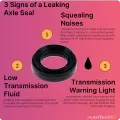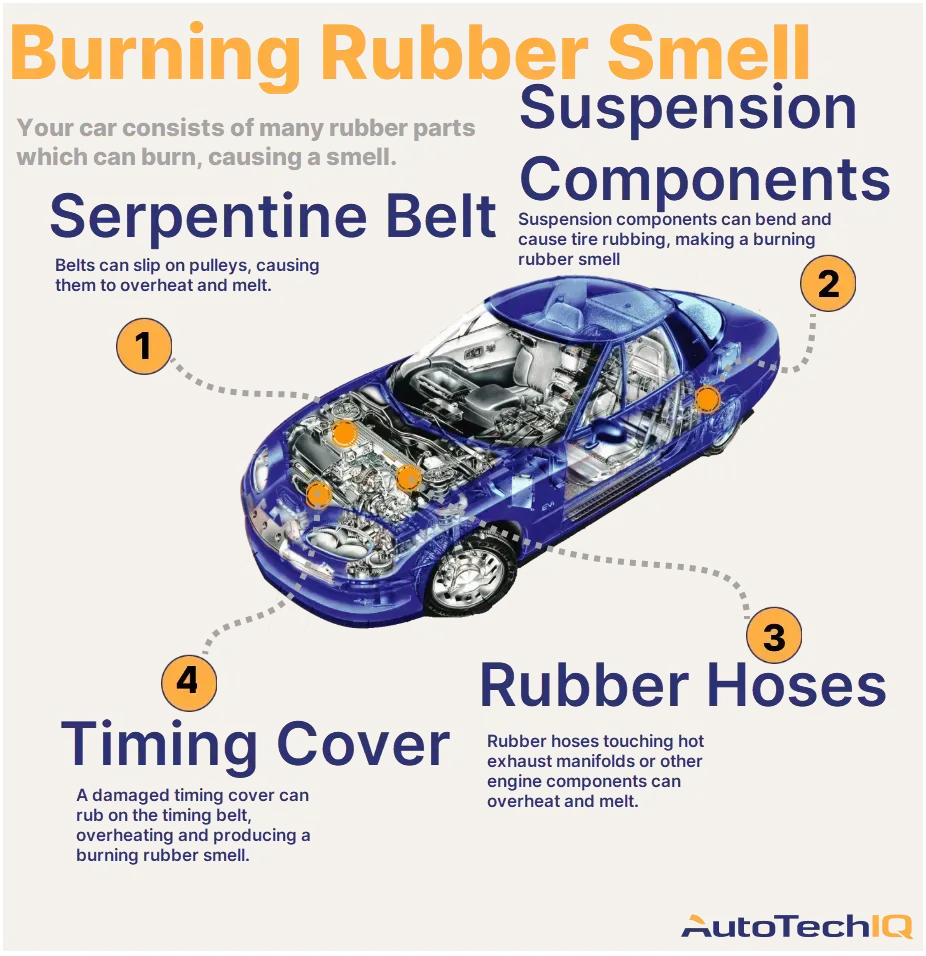

Burning rubber smells in vehicles can relate to electrical and brake systems. These systems have many rubber components (seals, insulation, wiring) that can overheat and burn, causing the smell.
Watch out: The burning rubber smell can mean a serious issue developing in your vehicle. Therefore, the safest action after noticing the smell is to safely pull over or reach a nearby shop. It can be unsafe to keep driving without knowing what’s happening.
Car parts aren’t meant to burn or melt away; if you’re feeling burning rubber smells in your car, something is going through extreme heat, which may mean:
-
Fire hazard risks: Car rubber components can endure high levels of heat; if they’re burning off something must be overheating extremely, creating fire risks.
-
Electrical problems: A burning rubber smell might be coming from wiring, insulation, or other electrical components, meaning your vehicle might lose electricity-powered steering, traction, or stability assistance.
-
Brake Issues: Burning smells in cars commonly point to brakes, meaning they’re being used excessively or are not functioning properly. Overheated brakes lose effectiveness and could cause a loss of braking power.
-
Health Concerns: A burning rubber can also produce harmful fumes that are hazardous to breathe. Additionally, if the vehicle overheats under the hood, a hot engine might not safely release toxic gases through the exhaust system; this can also cause burning engine oil smells.
Why does my car smell like burning rubber?
Your car smells like burning rubber because a rubber hose, pulley, or belt might have detached and touched some hot car part, burning and melting. Alternatively, it can be a rubber car part overheating and melting, or even road debris that got stuck in your car and it’s now burning as you drive.
The most common causes for a burning rubber smell
There are different causes for your car smelling like burning rubber. Here are the most common ones:
-
Melted car hoses: Overheating internal components can cause a burning rubber smell due to the breakdown of rubber hoses and belts. When the engine or other components become too hot, it can cause rubber hoses and belts to deteriorate, releasing a strong odor.
-
Slipping serpentine belt: A slipping serpentine belt can cause a burning rubber smell in a car due to friction and overheating. If the belt is loose, and slips, it can generate heat and friction, leading to a burning rubber smell as the belt deteriorates.
-
Faulty tensioner: A failed tensioner can cause a burning rubber smell in a car due to the increased friction and heat generated by a loose or misaligned serpentine belt. The tensioner maintains the proper tension of the serpentine belt, if it fails, it'll generate extra friction, causing the burning smell.
-
Bent suspension components: Bent suspension components can cause a burning rubber smell in a car due to the misalignment and increased friction between the tires and the road. This can lead to a burning rubber smell as the tires deteriorate.
-
Friction on the timing cover: Friction on the timing cover can cause a burning rubber smell in a car due to the rubbing of the timing belt or chain against the cover. This friction can generate heat and cause the belt or chain to deteriorate, emitting a burning rubber smell.
-
Faulty drive shaft center support bearing: The drive shaft center support bearing supports the drive shaft in its housing and allows it to rotate smoothly. If the bearing is faulty, it can cause the drive shaft to vibrate or wobble, leading to friction between the drive shaft and surrounding components.
When/where exactly is the burning rubber smell happening?
Your vehicle has various rubber materials in different systems and car parts. Therefore, the location where the smell is coming from indicates what component might be burning. You should also notice when the burning rubber smell starts: is it after driving? After turning the A/C on?
Here are common locations/situations where a burning rubber smell might appear in your vehicle:
Q: Do you typically drive on bumpy roads?
If you typically drive on bumpy roads, there might be a correlation that explains the smell. In this case, rubber parts like seals and sealings can deteriorate from impact. Then, these rubber bits fall and touch hot vehicle parts, burning themselves and creating a smell.
Acting early is crucial since rubber can deteriorate under high heat and mechanical failures. Components can get loose or lose their securing clips and pins through vibrations. If they dislocate and touch a hot part of the engine, they will burn, producing a unique smell.
Q: Are you noticing issues with your car's A/C, steering performance, radio system, and lights?
These symptoms can be caused by a faulty "belt-like" rubber component known as a serpentine — or accessory — belt. This component moves between gears and pulleys in the engine, providing power for systems like the A/C compressor, radio, water pumps, power steering, alternator, and lights.
So, if you're noticing an issue with any of these accessories/systems while also picking on a burning smell, explain this to a mechanic.
The burning rubber smell happens in this case because this belt can degrade, damaging some pulleys' bearings, loosening itself, and touching hot parts. Sometimes, the spring-loaded tensioners might be underperforming, causing the belt's looseness.
Q: Does the smell appear periodically and cease for a long time?
There are various components under the car and its hood that have rubber covers and sealings. In some cases, driving conditions and collisions can cause some systems to misalign. If a component with a rubber layer gets out of place enough to touch a hot part of the car, it'll produce a burning rubber smell. The protective rubber covering might contact extremely hot parts like an exhaust manifold and melt.
Q: Is your car's suspension less smooth than it used to be?
Sometimes, a bent suspension component might stretch out of place and rub against the tires. This rubbing motion will cause excess friction, produce heat, and make burning smells from the tire's rubber. You'll also notice rougher steering when trying to turn the car like it's heavier than it used to be.
Q: Do you typically drive under rough terrain with gravel and road debris?
There's a cover on the engine that protects some components like belts and chains. This cover is called the timing cover, and it's like a "shield." Driving the car under rough terrain can cause this cover to lose integrity, developing cracks or leaks.
In some cases, the timing cover might develop a big crack and allow debris to enter it. Then, debris inside can make overheating easier, damaging plastic and rubber elements like the timing belt. In this case, tracking the problem is tricky since the smell doesn't accompany any noises. So, if you smell the odor in your car, head to an auto shop urgently.
Q: Have you checked under your car for melted rubber?
A few car problems leave trails under the vehicle, which is the case with a drive shaft center support bearing. This part is a cylindrical structure under the car that supports the driveshaft (a long metal rod under the car that connects to the wheels).
When a drive shaft center support bearing fails, it leaves traces of rubber and dust on the car's underside. These rubber particles can fall on hot parts of the car's suspension or related structures, melting and creating a burning smell. In this case, handling the car further melts these particles, producing a burnt rubber odor.
Typical fixes to address the cause(s)
These are typical processes and repair services that fix a burning rubber issue
-
Tensioner replacement
The most common cause: A serpentine belt
The most common reason for a car making a burning rubber smell is because of a serpentine belt. The belt can overheat and burn itself and rubber pulleys, causing a burning rubber smell. The serpentine belt can even slip out of place and rub against other hot components, increasing the burning smell.
Some pulleys are made of material that cannot endure the serpentine’s belt heat due to low belt tension, overloaded components, failed bearings, and seized components, which is why they can melt.
-
Origin of the smell: Under the hood.
-
Symptoms it causes: Apart from the burning rubber smell, this can cause problems with the air conditioning, steering performance, radio system, internal lights, and headlights.
-
High risk of priority: The belt can quickly overheat, slip, and damage other components.
What exactly is a serpentine belt?
The serpentine belt, also called a multi-rib or poly-v belt, is a long, looped belt made of rubber. The belt runs along grooves on pulleys attached to the alternator, power steering pump, air conditioner compressor, and water pump (in some cases).
-
Key function: In short, the key function of the serpentine belt is to deliver power from the crankshaft to essential engine components like the alternator, power steering pump, air conditioning compressor, and sometimes the water pump. It basically feeds the electrical system and helps power your car’s A/C, radio, accessories, lights, etc.
Although the serpentine belt is a common cause of burning rubber smells in a vehicle, do not assume it’ll be the case for you. Many other car parts are rubber and can be the culprit.
Go safe: Ask for a mechanic to inspect your vehicle to track the burning rubber smell’s location and how it affects other components. Many shops do transparent vehicle inspections and lay out your options after investigating your vehicle’s conditions.
What’s a vehicle inspection? It’s “detective work” on your vehicle, checking its systems to find if anything is preventing the car from working as expected. In this case, mechanics examine different parts of your vehicle to track where the burning smell is coming from and what’s causing it. They’ll also check the condition of components during their inspection, noting which are causing the problem and which got affected by it, recommending to replace them in order of priority.
Transparency example in a serpentine belt service
Let’s see how a vehicle inspection defines the car service needed to fix a serpentine belt problem causing burning rubber smells.
In this example, the technician found that the serpentine belt had slipped out of place. The serpentine belt is a critical component under a vehicle's hood; it transfers the power from the engine to basically everything else, like the alternator, power steering, A/C, and more.
The serpentine belt is connected to the water pump in most vehicle engines. This vehicle's water pump pulley has composite material, which can endure high temperatures. Unfortunately, the mechanic discovered that the slipping serpentine belt was causing excessive heat.
Although the pulley’s material endures high temperatures, the serpentine belt can overheat too much for too long. Consequently, the pump pulley was enduring beyond its resistance and started to melt, causing a burning smell.
With these findings, the technician will also take a look at the water pump and belt tensioner. Then, they'll plan a fix for the whole system.
The image below shows the melted pulley and belt, causing the burning rubber smell. Hence, replacing both parts is crucial to avoid overheating failure.

In this case, the mechanic put the “Immediate Action” tag on the serpentine belt and water pump pulley. They also recommended replacing surrounding components that got worn out.
Similar Symptoms
Different strange smells can come from a car, and they’re all important to understand; here are articles that may be relevant to you right now:
Other news
-
Car is Squealing When Driving
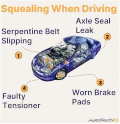
-
What is Preventative Maintenance and What Are The Benefits of it?

-
JobViewIQ - DVI Process Training - Part of the Auto Care Alliance Benefits

-
7 Signs of AC Pulley Issues
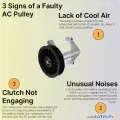
-
7 Signs of Clogged AC Components
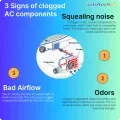
-
How Much Does a Transmission Fluid Change Cost?

-
7 Signs of a Leaking Axle Seal
